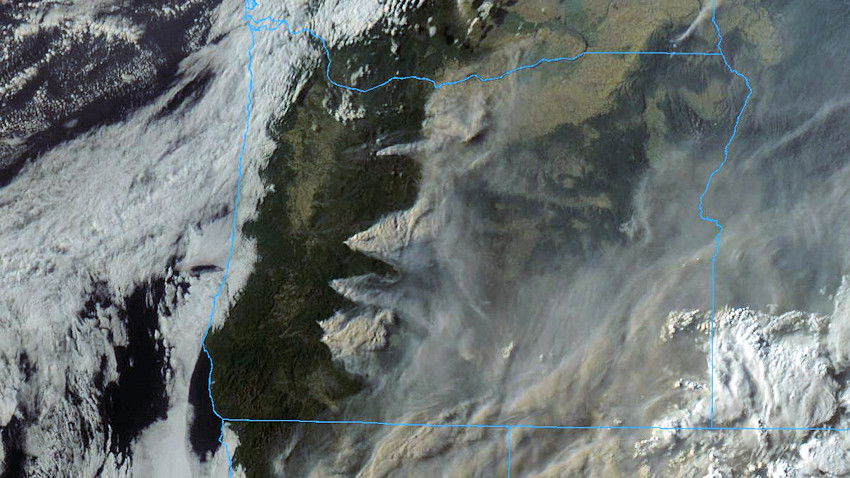NW fire bosses’ pre-Labor Day warning: Danger still high, despite cooler temps

'Everyone needs to be extremely careful'
PORTLAND, Ore. (KTVZ) -- While there is some relief from this summer’s extreme heat, high fire danger will likely continue into September because of the ongoing drought. Northwest fire officials warned Monday.
Severe drought and record-breaking temperatures have contributed to extreme fire behavior and have made firefighting conditions very difficult. Fire officials say conditions remain dry and any spark could start a wildfire that could quickly spread.
“Right now everyone needs to be extremely careful,” says Oregon Department of Forestry Protection from Fire Division Chief Doug Grafe. “With the current conditions, just a spark, cigarette, or open flame could start the next wildfire. As we’ve already had a long fire season, we need your help preventing fires to help protect our firefighters and communities.”
(Meanwhile, the fire danger in California is so great, the Forest Service announced Monday a temporary closure of all of the state's national forests, from 11:59 p.m. Tuesday through Sept. 17.)
Typically, the Pacific Northwest experiences widespread, sustained east and northeast winds beginning in late August and throughout the Fall. This wind can lower humidity and increase fire danger, as well as drive the spread of new fires and increase activity on existing wildfires. The main effects of this wind are in the Coast Range and on the west slopes of the Cascades.
There is not currently a significant east wind event in the forecast, like the one that caused massive devastation a year ago, but officials say it is good to be aware of this wind pattern and the effects it can have on wildfires.
While awareness of the conditions is important, officials also remind the public to adhere to fire restrictions that are in place to help prevent human-caused wildfires. Common day-to-day activities like mowing dry grass, off-road driving and campfires are not allowed in most areas. Campfire bans remain in place on state lands in Oregon east of Interstate 5 and many other federal lands, and there are a number of area closures in place.
“Know before you go,” says Keep Oregon Green Association’s Kristin Babbs. “Either call ahead or log on to one of the many government agency, private land, or commercial recreation websites that provide this valuable information.”
Homeowners and outdoor enthusiasts alike can contribute to the fire prevention effort by reducing fire-prone activities. Outdoor debris burning remains prohibited throughout much of the region and campfires are either prohibited entirely or only allowed in designated campgrounds. While logging activity is being curtailed under these extreme conditions, many large industrial landowners have also closed their gates to public access in efforts to reduce possible ignitions from off-road driving, target shooting, smoking and campfires; all of which are illegal or restricted during fire season.
“Even with the cooler overnight weather Oregon has seen, the fire risk is still present,” State Fire Marshal Mariana Ruiz-Temple said, urging Oregonians to be prepared in case an evacuation is necessary. “With the current fire risk, people should take a moment to make sure they have prepared themselves and their family for evacuation.”
As of August 29, 3,027 fires have burned 1,276,795 acres in Oregon and Washington according to the Northwest Interagency Coordination Center in Portland. Over 2,000 fires have been human-caused. For additional information on fire prevention and restrictions in your area, please visit any of the websites below.
Oregon Department of Forestry: www.oregon.gov/ODF/Fire/Pages/Restrictions.aspx
Keep Oregon Green: www.keeporegongreen.org
Washington Department of Natural Resources: www.dnr.wa.gov/WildfirePrevention
Oregon State Fire Marshal: www.oregon.gov/osp/sfm/
Bureau of Land Management: https://www.blm.gov/orwafire
Northwest Interagency Coordination Center: https://gacc.nifc.gov/nwcc/
###
The Pacific Northwest Wildfire Coordinating Group is established to provide a coordinated interagency approach to wildfire management in Oregon and Washington. PNWCG provides leadership in interface and wildland fire management for local, tribal, state and federal agencies and their constituents to enhance firefighter safety and protection of life, property, and natural resources. PNWCG is comprised of USDA-Forest Service; USDI-Bureau of Land Management, Bureau of Indian Affairs, National Park Service, Fish and Wildlife Service; Oregon Department of Forestry; Washington Department of Natural Resources; Washington Association of Fire Chiefs; The Oregon Fire Chiefs Association; The Oregon State Fire Marshal and the Washington State Fire Marshal.